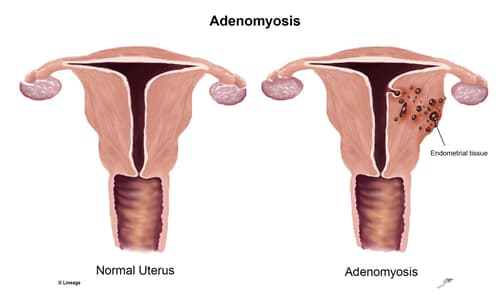Snapshot
- A 35-year-old woman with a long history of heavy menses and cramps presents with progressively worsening symptoms over the course of a few month. She has also gained weight. During the interview, she asked about the use of hormonal contraception. On physical exam, the uterus was enlarged, smooth, boggy, and tender. She elected to treat with hormonal contraceptives to preserve fertility instead of undergoing hysterectomy.
Overview

Introduction
- Invasion of endometrial glands into uterine myometrium
- Pathogenesis
- largely unknown
- hyperplasia of basalis layer of endometrium
- Epidemiology
- women ages 35-50
- Associated conditions
- often coexists with other uterine diseases
- leiomyomas
- often coexists with other uterine diseases
- endometriosis
Presentation
Evaluation

- nitial test to order in patient with enlarged uterusI
- β-hCG
- Diagnosis is based on clinical history and exam
- Imaging
- sonogram shows diffusely enlarged uterus with some cystic areas within myometrium
- Definitive diagnosis with hysterectomy and histology
Differential Diagnosis
Treatment
- Symptomatic treatment for dysmenorrhea
- hormonal contraceptives
- e.g., levonorgestrel-releasing intrauterine contraception
- hormonal contraceptives
- When fertility is no longer needed or failure of medical management
- hysterectomy
Complications
- Controversial evidence linking adenomyosis with infertility



